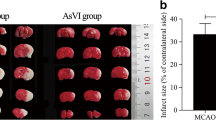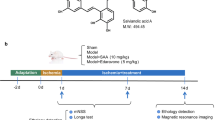Abstract
Promoting neurogenesis and proliferation of endogenous neural stem/progenitor cells (NSPCs) is considered a promising strategy for neurorehabilitation after stroke. Our previous study revealed that a moderate dose of artesunate (ART, 150 mg/kg) could enhance functional recovery in middle cerebral artery occlusion (MCAO) mice. This study aimed to investigate the effects of ART treatment on neurogenesis and proliferation of NSPCs using a rodent MCAO model. MRI results indicated that the ischemic brain volume of MCAO mice was reduced by ART treatment. The results of diffusion tensor imaging, electron microscopic, and immunofluorescence of Tuj-1 also revealed that ischemia-induced white matter lesion was alleviated by ART treatment. After ischemia/reperfusion, the proportion of Brdu + endogenous NSPCs in the ipsilateral subventricular zone and peri-infarct cortex was increased by ART treatment. Furthermore, the neuro-restorative effects of ART were abolished by the overexpression of FOXO3a. These findings suggested that ART could rescue ischemia/reperfusion damage and alleviate white matter injury, subsequently contributing to post-stroke functional recovery by promoting neurogenesis and proliferation of endogenous NSPCs via the FOXO3a/p27Kip1 pathway.






Similar content being viewed by others
Data Availability
Not applicable and the datasets used in this study were available from the corresponding author upon reasonable request.
The Ethics Committee of the Third Military Medical University approved all the animal work protocols (approval no. AMUWEC20201153). The experiments were performed in concordance with Animal Research standards: Reporting of In Vivo Experiments (ARRIVE) guidelines.
Abbreviations
- NSPCs:
-
Neural stem/progenitor cells
- ART:
-
Artesunate
- MCAO:
-
Middle cerebral artery occlusion
- FOXO3a:
-
Forkhead box O3a
- p27kip1 :
-
Cyclin-dependent kinase inhibitor 1B
- CDK2:
-
Cyclin-dependent Kinase 2
- MRI:
-
Magnetic resonance imaging
- DTI:
-
Diffusion tensor imaging
- FA:
-
Fractional anisotropy values
- ADC:
-
Apparent diffusion coefficient value
- IC:
-
Internal capsule
- SVZ:
-
Subventricular zone
- SGZ:
-
Subgranular zone of hippocampal dentate gyrus
- TTC:
-
2, 3, 5-Triphenyltetrazolium hydrochloride
- BrdU:
-
Bromodeoxyuridine
- DCX:
-
Doublecortin
- Tuj-1:
-
Neuron-specific class III beta-tubulin
References
Virani SS, Alonso A, Benjamin EJ, Bittencourt MS, Callaway CW, Carson AP, Chamberlain AM, Chang AR et al (2020) Heart Disease and Stroke Statistics-2020 update: a report from the American Heart Association. Circulation 141(9):e139–e596
Tan L, Margaret B, Zhang JH, Hu R, Yin Y, Cao L, Feng H, Zhang Y (2015) Efficacy and safety of cilostazol therapy in ischemic stroke: a meta-analysis. J Stroke Cerebrovasc Dis 24(5):930–938
Bond AM, Ming GL, Song H (2015) Adult mammalian neural stem cells and neurogenesis: five decades later. Cell Stem Cell 17(4):385–395
Zhu X, Yan J, Bregere C, Zelmer A, Goerne T, Kapfhammer JP, Guzman R, Wellmann S (2019) RBM3 promotes neurogenesis in a niche-dependent manner via IMP2-IGF2 signaling pathway after hypoxic-ischemic brain injury. Nat Commun 10(1):3983
Wang J, Hu J, Chen X, Lei X, Feng H, Wan F, Tan L (2021) Traditional Chinese medicine monomers: novel strategy for endogenous neural stem cells activation after stroke. Front Cell Neurosci 15:628115
Pekyi D, Ampromfi AA, Tinto H, Traoré-Coulibaly M, Tahita MC, Valéa I, Mwapasa V, Kalilani-Phiri L et al (2016) Four artemisinin-based treatments in African pregnant women with malaria. N Engl J Med 374(10):913–927
Dondorp AM, Fanello CI, Hendriksen IC, Gomes E, Seni A, Chhaganlal KD, Bojang K, Olaosebikan R et al (2010) Artesunate versus quinine in the treatment of severe falciparum malaria in African children (AQUAMAT): an open-label, randomised trial. Lancet 376(9753):1647–1657
Sinclair D, Donegan S, Isba R, Lalloo DG (2012) Artesunate versus quinine for treating severe malaria. Cochrane Database Syst Rev 2012(6):Cd005967
Drecourt A, Babdor J, Dussiot M, Petit F, Goudin N, Garfa-Traoré M, Habarou F, Bole-Feysot C et al (2018) Impaired transferrin receptor palmitoylation and recycling in neurodegeneration with brain iron accumulation. Am J Hum Genet 102(2):266–277
Efferth T, Dunstan H, Sauerbrey A, Miyachi H, Chitambar CR (2001) The anti-malarial artesunate is also active against cancer. Int J Oncol 18(4):767–773
Sordi R, Nandra KK, Chiazza F, Johnson FL, Cabrera CP, Torrance HD, Yamada N, Patel NS et al (2017) Artesunate protects against the organ injury and dysfunction induced by severe hemorrhage and resuscitation. Ann Surg 265(2):408–417
Wan RJ, Li YH (2017) Effects of Artesunate prevent nephritis via the Toll-like receptor 4/nuclear factor-κB signaling pathway in rats. Mol Med Rep 16(5):6389–6395
Kasaragod VB, Hausrat TJ, Schaefer N, Kuhn M, Christensen NR, Tessmer I, Maric HM, Madsen KL et al (2019) Elucidating the molecular basis for inhibitory neurotransmission regulation by artemisinins. Neuron 101(4):673-689.e611
Zuo S, Ge H, Li Q, Zhang X, Hu R, Hu S, Liu X, Zhang JH et al (2017) Artesunate protected blood-brain barrier via sphingosine 1 phosphate receptor 1/phosphatidylinositol 3 kinase pathway after subarachnoid hemorrhage in rats. Mol Neurobiol 54(2):1213–1228
Zhang K, Yang Y, Ge H, Wang J, Chen X, Lei X, Zhong J, Zhang C et al (2020) Artesunate promotes the proliferation of neural stem/progenitor cells and alleviates Ischemia-reperfusion Injury through PI3K/Akt/FOXO-3a/p27(kip1) signaling pathway. Aging (Albany NY) 12(9):8029–8048
Paik JH, Ding Z, Narurkar R, Ramkissoon S, Muller F, Kamoun WS, Chae SS, Zheng H et al (2009) FoxOs cooperatively regulate diverse pathways governing neural stem cell homeostasis. Cell Stem Cell 5(5):540–553
Zhang W, Bergamaschi D, Jin B, Lu X (2005) Posttranslational modifications of p27kip1 determine its binding specificity to different cyclins and cyclin-dependent kinases in vivo. Blood 105(9):3691–3698
Tomoda K, Kubota Y, Kato J (1999) Degradation of the cyclin-dependent-kinase inhibitor p27Kip1 is instigated by Jab1. Nature 398(6723):160–165
Faiz M, Sachewsky N, Gascón S, Bang KW, Morshead CM, Nagy A (2015) Adult neural stem cells from the subventricular zone give rise to reactive astrocytes in the cortex after stroke. Cell Stem Cell 17(5):624–634
Pivonkova H, Anderova M (2017) Altered homeostatic functions in reactive astrocytes and their potential as a therapeutic target after brain ischemic injury. Curr Pharm Des 23(33):5056–5074
Couillard-Despres S, Winner B, Schaubeck S, Aigner R, Vroemen M, Weidner N, Bogdahn U, Winkler J et al (2005) Doublecortin expression levels in adult brain reflect neurogenesis. Eur J Neurosci 21(1):1–14
Zhong J, Li RW, Wang J, Wang Y, Ge HF, Xian JS, Feng H, Tan L (2021) Neuroprotection by cattle encephalon glycoside and ignotin beyond the time window of thrombolysis in ischemic stroke. Neural Regen Res 16(2):312–318
Yeo SS, Choi BY, Chang CH, Jung YJ, Ahn SH, Son SM, Byun WM, Jang SH (2011) Periventricular white matter injury by primary intraventricular hemorrhage: a diffusion tensor imaging study. Eur Neurol 66(4):235–241
Swanson RA, Morton MT, Tsao-Wu G, Savalos RA, Davidson C, Sharp FR (1990) A semiautomated method for measuring brain infarct volume. J Cereb Blood Flow Metab 10(2):290–293
Liang T, Chen Q, Li Q, Li R, Tang J, Hu R, Zhong J, Ge H et al (2017) 5-HT1a activation in PO/AH area induces therapeutic hypothermia in a rat model of intracerebral hemorrhage. Oncotarget 8(43):73613–73626
Moskowitz MA, Lo EH, Iadecola C (2010) The science of stroke: mechanisms in search of treatments. Neuron 67(2):181–198
Zhang J, Sun X, Wang L, Wong YK, Lee YM, Zhou C, Wu G, Zhao T et al (2018) Artesunate-induced mitophagy alters cellular redox status. Redox Biol 19:263–273
Zuo S, Li Q, Liu X, Feng H, Chen Y (2016) The potential therapeutic effects of artesunate on stroke and other central nervous system diseases. Biomed Res Int 2016:1489050
Eckert A, Huang L, Gonzalez R, Kim HS, Hamblin MH, Lee JP (2015) Bystander effect fuels human induced pluripotent stem cell-derived neural stem cells to quickly attenuate early stage neurological deficits after stroke. Stem Cells Transl Med 4(7):841–851
Bacigaluppi M, Russo GL, Peruzzotti-Jametti L, Rossi S, Sandrone S, Butti E, De Ceglia R, Bergamaschi A et al (2016) Neural stem cell transplantation induces stroke recovery by upregulating glutamate transporter GLT-1 in astrocytes. J Neurosci 36(41):10529–10544
Chang DJ, Lee N, Park IH, Choi C, Jeon I, Kwon J, Oh SH, Shin DA et al (2013) Therapeutic potential of human induced pluripotent stem cells in experimental stroke. Cell Transplant 22(8):1427–1440
Sakata H, Narasimhan P, Niizuma K, Maier CM, Wakai T, Chan PH (2012) Interleukin 6-preconditioned neural stem cells reduce ischaemic injury in stroke mice. Brain 135(Pt 11):3298–3310
Fuentealba LC, Obernier K, Alvarez-Buylla A (2012) Adult neural stem cells bridge their niche. Cell Stem Cell 10(6):698–708
Takagi T, Yoshimura S, Sakuma R, Nakano-Doi A, Matsuyama T, Nakagomi T (2017) Novel regenerative therapies based on regionally induced multipotent stem cells in post-stroke brains: their origin, characterization, and perspective. Transl Stroke Res 8(6):515–528
Ferber EC, Peck B, Delpuech O, Bell GP, East P, Schulze A (2012) FOXO3a regulates reactive oxygen metabolism by inhibiting mitochondrial gene expression. Cell Death Differ 19(6):968–979
Roy S, Kaur M, Agarwal C, Tecklenburg M, Sclafani RA, Agarwal R (2007) p21 and p27 induction by silibinin is essential for its cell cycle arrest effect in prostate carcinoma cells. Mol Cancer Ther 6(10):2696–2707
Han J, Zhao J, Jiang J, Ma X, Liu X, Wang C, Jiang S, Wan C (2015) Zinc deficiency impairs the renewal of hippocampal neural stem cells in adult rats: involvement of FoxO3a activation and downstream p27(kip1) expression. J Neurochem 134(5):879–891
Funding
This study was supported by the Military Medicine Pre-research Project of Army Medical University(2018XYY11), National Natural Science Foundation of China (81901267), the Natural Science Foundation of Chongqing (Grant no. cstc2019jcyj-msxmX0458), and Youth Natural Science Foundation of Xinjiang (2022D01C346). The funders were not involved in study design, data collection/interpretation, and the decision to submit the publication results.
Author information
Authors and Affiliations
Contributions
KYZ performed most of the experiments, with assistance from YY and XZC XJL, and YY analyzed the results and produced the figures. KYZ conducted statistical analysis. FW and HFG performed animal experiments. XZC, XJC, and HFG conducted immunoblotting and immunostaining. KYZ drafted the manuscript. YY and LT reviewed the manuscript. LT and HF designed experiments. All authors approved the final version of the document.
Corresponding author
Ethics declarations
Consent to Participate
Not applicable.
Consent for Publication
All the authors agreed to the publication.
Competing Interests
The authors declare no competing interests.
Additional information
Publisher's Note
Springer Nature remains neutral with regard to jurisdictional claims in published maps and institutional affiliations.
Supplementary Information
Below is the link to the electronic supplementary material.
Rights and permissions
About this article
Cite this article
Zhang, K., Yang, Y., Ge, H. et al. Neurogenesis and Proliferation of Neural Stem/Progenitor Cells Conferred by Artesunate via FOXO3a/p27Kip1 Axis in Mouse Stroke Model. Mol Neurobiol 59, 4718–4729 (2022). https://doi.org/10.1007/s12035-021-02710-5
Received:
Accepted:
Published:
Issue Date:
DOI: https://doi.org/10.1007/s12035-021-02710-5




